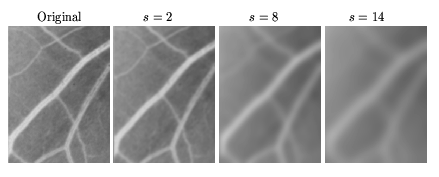Multiscale techniques have been developed to provide a way to isolate,
analyse and interpret structures
of different scales within an image [13].
The main idea of a multiscale representation is to generate a
one-parameter family of derived images ![]() by
convolving the original image
by
convolving the original image ![]() with a Gaussian kernel
with a Gaussian kernel ![]() of
variance
of
variance ![]() :
:
 |
The use of Gaussian kernels to generate multiscale information ensures that
the image analysis is invariant with respect to
translation, rotation and size [14,15]. The derivatives of
an image are defined as the linear convolution of the image with scale-normalised
derivatives of the Gaussian kernel.
The normalisation by scale makes the derivatives dimensionless which means that the derivatives will have the proper behaviour under spatial rescaling of the original image and that structures at different scales will be treated in a similar manner. An approach advocated by Koenderink [14] is to describe image properties in terms of differential geometric descriptors which constitutes a natural framework for expressing both physical processes and geometrical properties. For retinal blood vessels we suggest that gradient magnitudes and principal curvatures of the Hessian tensor are the most useful geometrical descriptors of the vessels which can be extracted.